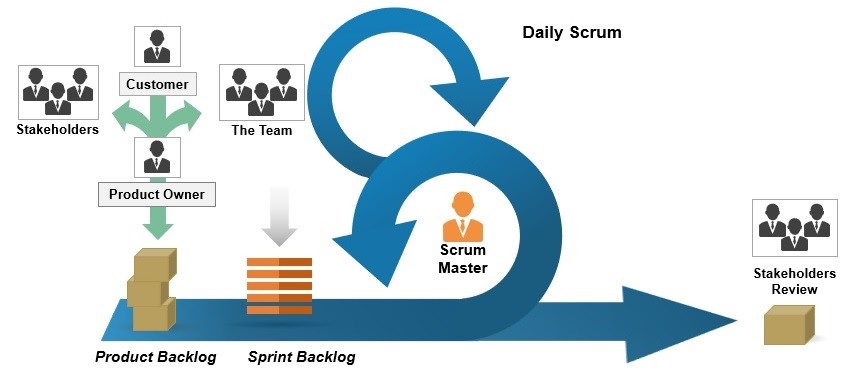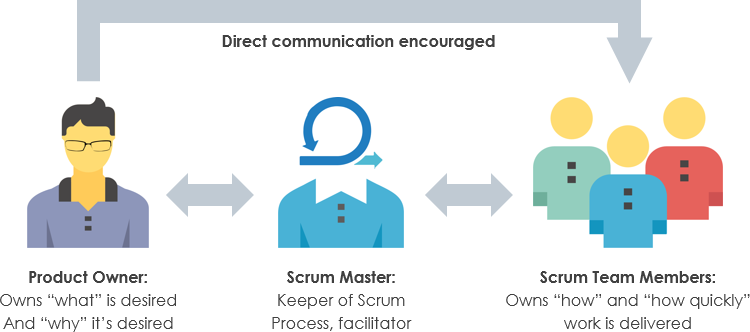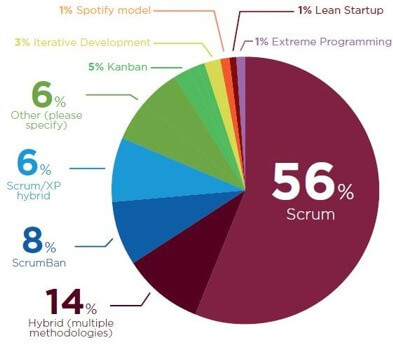Agile Scrum methodology is something that probably does not exist according to many experts. Now, combining Agile with Scrum methodologies can be an an effective method of developing products and many organizations use based on what they think will work for them. Agile Scrum Methodology is an agile software development approach methodology built on iterative and incremental procedures. The scrum project management methodology allows companies to prioritize work and scale agile better. Be it critical work or divide it into chunks with similar tasks.
This tends to be a controversial subject. When people talk about Agile Scrum methodology, they often do not mention agile or try not to “mix” the subjects. The way we see it. Agile is a general approach to software development. Scrum is a particular way of doing agile focused on scale.
Scrum framework is adaptive, rapid, and creative. It is successful at delivering value to the client. But its primary goal is to meet customer needs by fostering open communication.

History of Agile Scrum mehodology
…Takeuchi and Nonaka tried different product development techniques. His efforts failed to reach the optimal product development strategy. Then with the failure eventually, they discovered scrum…
The history of Scrum goes back to 1986. It happened when Takeuchi and Nonaka tried different product techniques. With failure, eventually, they discovered Scrum product development. This highlights the key role of self-organized teams.
Later, in 1993, Jeff Sutherland and his team developed the Agile Scrum methodology. It was done for use in software dev.
Process of Agile Scrum Methodology
Agile Scrum methodology focuses on a specified set of activities and responsibilities that are part of the process. Moreover, it’s a highly versatile technique. So, it helps adapt the agile principles agreed by team members.
Agile Scrum methodology or framework implements short, periodic chunks called sprints, lasting between two and four weeks each. They are very helpful in tracking feedback.
The procedure begins with a list of project objectives/requirements. Then, the project’s client prioritizes these goals based on a trade-off between their value and cost. So, this is how we define iterations and deliverables.
Roles of Agile Scrum Methodology
The Scrum team aims to produce high-quality software. Therefore, the Scrum project owner identifies what qualities the product must have. Then this allows to develop (what to create, what not to create) and overcome obstacles that may obstruct the team’s tasks.

The Scrum team consists of:
Scrum Master
The Scrum Master ensures that the team follows the rules and practices of the framework. This means handling the project’s obstacles and collaborating with the Product Owner to optimize ROI. In addition, the Scrum Master is responsible for maintaining Scrum up to date. But that’s not all! The Scrum Master also provides team guidance, advising, and coaching.
Product Owner
The Product Owner (PO) represents the product’s stakeholders and customers. They concentrate on the business side and are also in charge of the project’s return on investment. Their duties include confirming the benefits in stories added to the Product Backlog and what to prioritize. In addition, the PO communicates the project’s vision to the team.
Team Members
Team members refer to a group of people with vital technical skills who work together. Hence, their objective is to complete the project and complete the stories they commit to at the beginning of each sprint, etc.
Scrum Events
Each Scrum event allows some part of the process, product, progress, or relationships to be modified.
Sprint
A Sprint is the fundamental work unit of a Scrum team. This is the significant difference between Scrum and other agile development methodologies.
Sprint Planning
Sprint Planning aims to specify what we can do during the Sprint and how to achieve it. This occurs at the start of each Sprint.
Real scenarios define how we will approach the project based on the Product Backlog phases and timelines.
Daily Scrum
The Daily Scrum aims to analyze progress and trends through Sprint’s conclusion. This includes coordinating activities and developing a strategy for the next 24 hours. It is generally a short gathering that occurs daily during the Sprint timeframe. We address three separate questions: What did I do yesterday? How am I going to spend my day? What assistance do I require? In addition, the Scrum Master attempts to resolve any issues.
Sprint Review
The sprint review’s objective is to show what work has been done. After the sprint, there should be an evident and provable improvement in the product to offer to the customer. This concerns the product backlog for future delivery.
Sprint Retrospective
The Sprint Retrospective phase makes changes to the development process. The SR identifies potential process changes. Then it helps develop a strategy for enforcing them in the next Sprint.
Scrum Artefacts
Product Backlog
It is a set of user stories for a scrum product. The product owner is responsible for creating and maintaining the product backlog. The product owner prioritizes is the artefacts. So that the team may contribute to it with the product owner’s consent.
Release Backlog
A release is a period during which we accomplish specific iterations. The release backlog contains stories which schedule to finish in a sure release. The product owner and scrum master collaborate to determine which stories should be prioritized for release.
Sprint Backlog
The sprint backlog is a collection of user stories to be fulfilled within the sprint. The team owns and controls it, with the remaining work calculated daily. Moreover, the team signs up for tasks.
The Most Popular Agile Scrum Methodology Framework?
The State of Agile report investigated the most popular agile development approaches. Team members adopt the agile Scrum technique the most. However, this system has limitations. Several firms also use Agile practices or methods to compensate for Scrum’s limitations.
- 8% utilize ScrumBan. Scrumban is a popular Scrum/Kanban combination.
- 6% utilize Scrum/XP Hybrid. Two Agile procedures are helpful as they can be together.
- 5% of teams utilize Kanban. The kanban board is a visual planning tool that presents each project on a card.
According to the results of the report:
- Scrum is used in 94% of respondents’ agile practices. 84% of the organizations use Scrum with other frameworks, while 16% use Scrum entirely.
- An average Scrum team consists of seven persons.
- A Sprint lasts on average 2.4 weeks, whereas a Scrum project lasts 11.6 weeks.
- The ScrumMaster certification was the most popular in 2017. Nearly 85% of respondents obtained ScrumMaster certification and also selected it for its big financial rewards. Additionally, 40% of them earned a Product Owner. Today, most businesses provide several sorts of training, the most frequent of which are online and in-house.
Conclusion: Why use Agile Scrum Methodology?
Scrum is a clear and straightforward framework. The principles, artifacts, events, and roles are simple to comprehend. Then its approach eliminates uncertainties in the development phase while allowing enterprises to add their input.
Agile Scrum Methodology helps challenge projects by arranging complicated activities into user stories. In fact, the clearly defined responsibilities and events provide accountability and shared responsibility throughout the software development cycle. Finally, rapid releases keep the team engaged and users satisfied by allowing them to see progress in a short period.
While it may provide a hard culture transition for a new team, appointing a scrum master may take time, mainly if the development team uses the waterfall methodology. In addition, smaller iterations, daily scrum meetings, and sprint reviews.
However, the long term advantages surpass the early learning curve. In addition, Scrum’s success is in building complex products. Lastly, this is across various industries, making it an attractive framework for your firm to adopt.





